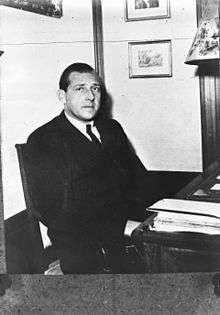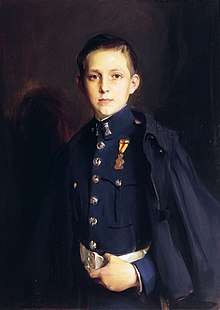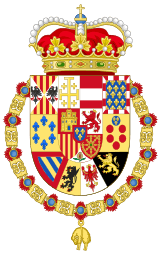Infante Juan, Count of Barcelona
Infante Juan of Spain, Count of Barcelona (Juan Carlos Teresa Silverio Alfonso de Borbón y Battenberg; 20 June 1913 – 1 April 1993), also known as Don Juan, was the third son and designated heir of King Alfonso XIII of Spain and Victoria Eugenie of Battenberg. His father was replaced by the Second Spanish Republic, and under his son, Juan Carlos I, a constitutional monarchy was installed.
| Infante Juan | |||||
|---|---|---|---|---|---|
| Count of Barcelona | |||||
 Don Juan de Borbón in 1946 | |||||
| Head of the Royal House of Spain | |||||
| Tenure | 15 January 1941 – 14 May 1977 | ||||
| Predecessor | Alfonso XIII | ||||
| Successor | Juan Carlos I | ||||
| Born | 20 June 1913 Royal Palace of La Granja de San Ildefonso, San Ildefonso, Kingdom of Spain | ||||
| Died | 1 April 1993 (aged 79) Navarra University Hospital, Pamplona, Kingdom of Spain | ||||
| Burial | 7 April 1993 El Escorial, Community of Madrid, Spain | ||||
| Spouse | |||||
| Issue | |||||
| |||||
| House | Bourbon | ||||
| Father | Alfonso XIII of Spain | ||||
| Mother | Victoria Eugenie of Battenberg | ||||
| Religion | Roman Catholic | ||||
Early life
Juan was born at the Palace of San Ildefonso. His father was forced into exile when the Second Spanish Republic was proclaimed on 14 April 1931. Owing to the renunciations of his brothers Alfonso of Spain, Prince of Asturias, and Infante Jaime, Duke of Segovia, Infante Juan was thus next in line to the defunct Spanish throne. He thus received the title Prince of Asturias when he was serving with the British Royal Navy in Bombay.
In March 1935, he passed his naval exams in gunnery and navigation, which would have entitled him to become a lieutenant in the Royal Navy if he gave up his Spanish nationality. This, however, he refused to do.
Marriage
He met his future wife at a party hosted by Victor Emmanuel III of Italy on the day before his sister (Infanta Beatriz) was to be married. He married Princess María de las Mercedes of Bourbon-Two Sicilies (1910–2000), known in Spain as Doña María de las Mercedes de Borbón Dos-Sicilias y Orleans, in Rome on 12 October 1935.
Just before the birth of the Infante Juan Carlos, the Count of Barcelona decided to go hunting, with the doctor telling him and his wife that the future king would not be born for weeks. When he was told of the birth, he drove to the hospital so quickly that he broke an axle spring.
Children
They had four children:
- Infanta Pilar, Duchess of Badajoz (30 July 1936 – 8 January 2020), who married Luis Gomez-Acebo y de Estrada, Viscount de la Torre, on 6 May 1967, and had five children
- Juan Carlos I of Spain (born 5 January 1938), who married Princess Sophia of Greece and Denmark on 14 May 1962, and had three children
- Infanta Margarita, Duchess of Soria (born 6 March 1939), who married Don Carlos Zurita y Delgado on 12 October 1972, and had two children
- Infante Alfonso of Spain (3 October 1941 – 29 March 1956)
They lived in Cannes and Rome, and, with the outbreak of World War II, they moved to Lausanne to live with his mother, Queen Victoria Eugenie. Afterwards, they resided at Estoril, on the Portuguese Riviera.
Claim to the Spanish throne

Juan became heir apparent to the defunct Spanish throne after the renunciations of his two older brothers, Alfonso and Jaime, in 1933. To assert his claim to the throne, following his father's death he used the title of Count of Barcelona, a sovereign title associated with the Spanish crown.
In 1936, his father sent him to participate in the Spanish Civil War but he was arrested near the French border, and sent back by General Emilio Mola.
When General Francisco Franco declared Spain a monarchy in 1947, he characterized it as a "restoration". However, Franco was afraid that Juan would roll back the Spanish State due to differing political views. As a result, in 1969, Franco passed over Juan in favour of Juan's son, Juan Carlos, who Franco believed would be more likely to continue the Francoist State after his death. Juan Carlos later surprised many by his support of democratising Spain. Franco and Juan did not have a good relationship, with the latter constantly pressing Franco to restore the monarchy. Relations soured further when Juan called Franco an "illegitimate usurper". Juan formally renounced his rights to the Spanish throne eight years after being displaced as recognised heir to the throne by Franco, and two years after his son, Juan Carlos, had become king. In return, his son officially granted him the title of Count of Barcelona, which he had claimed for so long.
He was buried with honours due a King, in the Royal Crypt of the monastery of San Lorenzo del Escorial, near Madrid. His wife survived him by seven years.
He was fond of the sea, and joined the Naval School at San Fernando, Cádiz, and had tattoos of a marine theme from his time in the British Royal Navy.
Arms
- Heraldry of Infante Juan of Spain, Count of Barcelona
.svg.png) Arms as Infante of Spain
Arms as Infante of Spain
(1927–1931/1933)-Escutcheon_of_France_and_Golden_Fleece_Variant.svg.png) Royal Coat of Arms of Spain
Royal Coat of Arms of Spain
Version of 1931
Used as Pretender and Head of the Royal House.
(1941–1977)[2]_Golden_Fleece_Variant.svg.png)
 Arms after the renunciation of the Throne
Arms after the renunciation of the Throne
(1977–1993)[3]
Ancestors
| Ancestors of Infante Juan, Count of Barcelona | |||||||||||||||||||||||||||||||||||||||||||||||||||||||||||||||||||||||||||||||||||||||||||||||||||||||||||||||||||||||||||||||||||||||||||||||||||||||||||||||||||||||||||||||||||||||||||||||||||||||||||||||||||||||||||||||||||||||||||||||||||||||||||||||||||||||||||||||||||||||||
|---|---|---|---|---|---|---|---|---|---|---|---|---|---|---|---|---|---|---|---|---|---|---|---|---|---|---|---|---|---|---|---|---|---|---|---|---|---|---|---|---|---|---|---|---|---|---|---|---|---|---|---|---|---|---|---|---|---|---|---|---|---|---|---|---|---|---|---|---|---|---|---|---|---|---|---|---|---|---|---|---|---|---|---|---|---|---|---|---|---|---|---|---|---|---|---|---|---|---|---|---|---|---|---|---|---|---|---|---|---|---|---|---|---|---|---|---|---|---|---|---|---|---|---|---|---|---|---|---|---|---|---|---|---|---|---|---|---|---|---|---|---|---|---|---|---|---|---|---|---|---|---|---|---|---|---|---|---|---|---|---|---|---|---|---|---|---|---|---|---|---|---|---|---|---|---|---|---|---|---|---|---|---|---|---|---|---|---|---|---|---|---|---|---|---|---|---|---|---|---|---|---|---|---|---|---|---|---|---|---|---|---|---|---|---|---|---|---|---|---|---|---|---|---|---|---|---|---|---|---|---|---|---|---|---|---|---|---|---|---|---|---|---|---|---|---|---|---|---|---|---|---|---|---|---|---|---|---|---|---|---|---|---|---|---|---|---|---|---|---|---|---|---|---|---|---|---|---|---|---|---|---|
| |||||||||||||||||||||||||||||||||||||||||||||||||||||||||||||||||||||||||||||||||||||||||||||||||||||||||||||||||||||||||||||||||||||||||||||||||||||||||||||||||||||||||||||||||||||||||||||||||||||||||||||||||||||||||||||||||||||||||||||||||||||||||||||||||||||||||||||||||||||||||
References
| Wikimedia Commons has media related to Infante Juan, Count of Barcelona. |
- Boletín Oficial del Estado
- García-Mechano y Osset, Eduardo (2010). Introducción a la heráldica y manual de heráldica militar española. Madrid: Ministerio de Defensa. ISBN 978-84-9781-559-8. PP.105-107
- "Coat of arms of Juan de Bourbon after his renounce at the emblem of the Frigate "Juan de Borbón"". Navy official coats of arms (in Spanish). Spanish Navy. Retrieved 18 March 2013.
Infante Juan, Count of Barcelona Cadet branch of the House of Capet Born: 20 June 1913 Died: 1 April 1993 | ||
| Spanish nobility | ||
|---|---|---|
| Preceded by Alfonso XIII |
Count of Barcelona 8 March 1941 – 1 April 1993 |
Succeeded by Juan Carlos I |
| Titles in pretence | ||
| Preceded by Alfonso XIII |
— TITULAR — King of Spain 15 January 1941 – 14 May 1977 Reason for succession failure: Republic proclaimed in 1931 |
Succeeded by Juan Carlos I |
_Version_with_Golden_Fleece_and_Charles_III_Orders.svg.png)